Rennie Scaysbrook | July 13, 2018
The Mountain Decides
Rennie and Team Cycle News/KTM North America headed back to Pikes Peak in 2018 for a third crack at the Heavyweight class and overall win. It turned out to be a race of truly epic proportions.
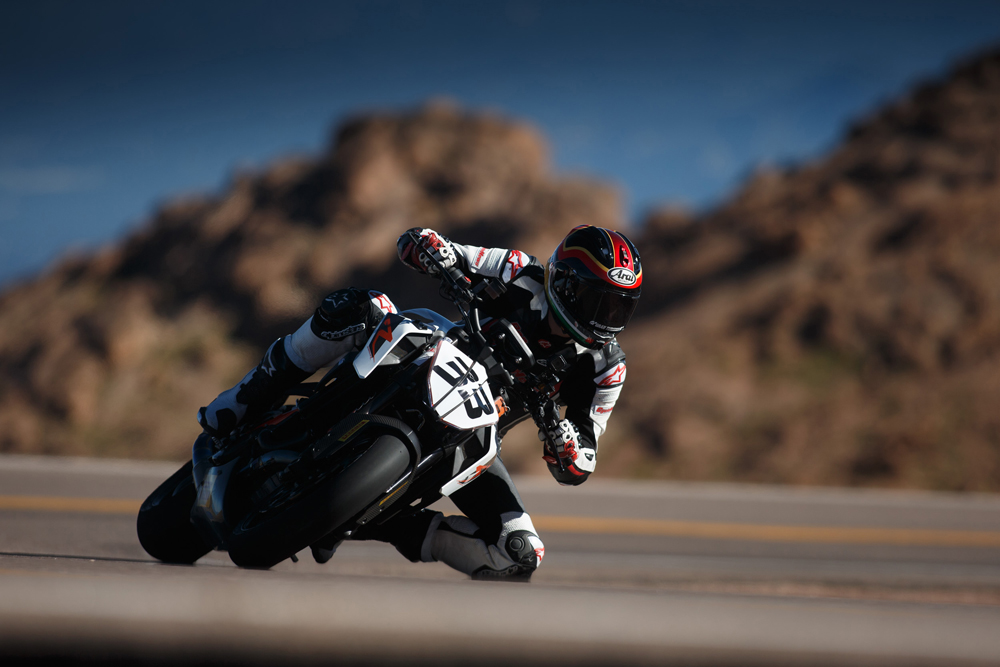 Charging through Boulder Park on Day Three of practice. It was all clicking at this point.
Charging through Boulder Park on Day Three of practice. It was all clicking at this point.
For the sixth time in one hour, I found myself taking a leak inside the plastic porta-potty. Bladder movements are more frequent in the hours and minutes leading up to the start of the Pikes Peak International Hill Climb, because you have plenty of time to sit and think about the task ahead of you. And plenty of time to ask yourself why you’re doing it.
Tension is part of the game in racing, but it’s put on hyper-status at America’s Mountain. It’s how you deal with it that makes for your mindset as you blip the motor down the corridor of well-wishers, with light-man Frank waiting for you at the start line.
There’s a possibility Frank will be the last person you ever speak to.
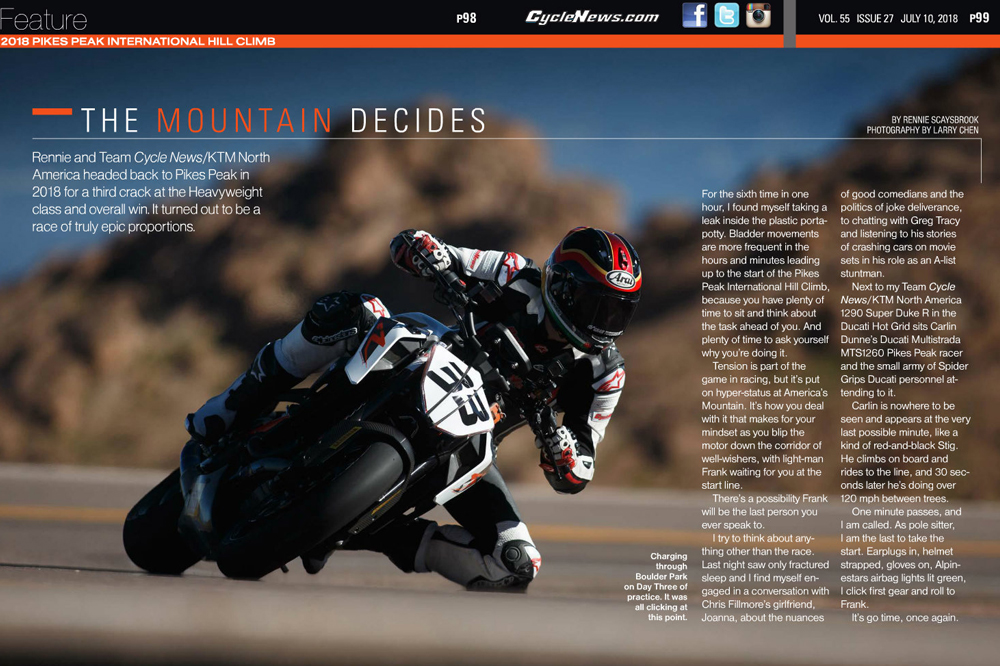
Click here to read this in the Cycle News Digital Edition Magazine.
Photography by Larry Chen
I try to think about anything other than the race. Last night saw only fractured sleep and I find myself engaged in a conversation with Chris Fillmore’s girlfriend, Joanna, about the nuances of good comedians and the politics of joke deliverance, to chatting with Greg Tracy and listening to his stories of crashing cars on movie sets in his role as an A-list stuntman.
Next to my Team Cycle News/KTM North America 1290 Super Duke R in the Ducati Hot Grid sits Carlin Dunne’s Ducati Multistrada MTS1260 Pikes Peak racer and the small army of Spider Grips Ducati personnel attending to it.
Carlin is nowhere to be seen and appears at the very last possible minute, like a kind of red and black Stig. He climbs on board and rides to the line, and 30 seconds later he’s doing over 120 mph between trees.
One minute passes, and I am called. As pole sitter, I am the last to take the start. Earplugs in, helmet strapped, gloves on, Alpinestars airbag lights lit green, I click first gear and roll to Frank.
It’s go time, once again.
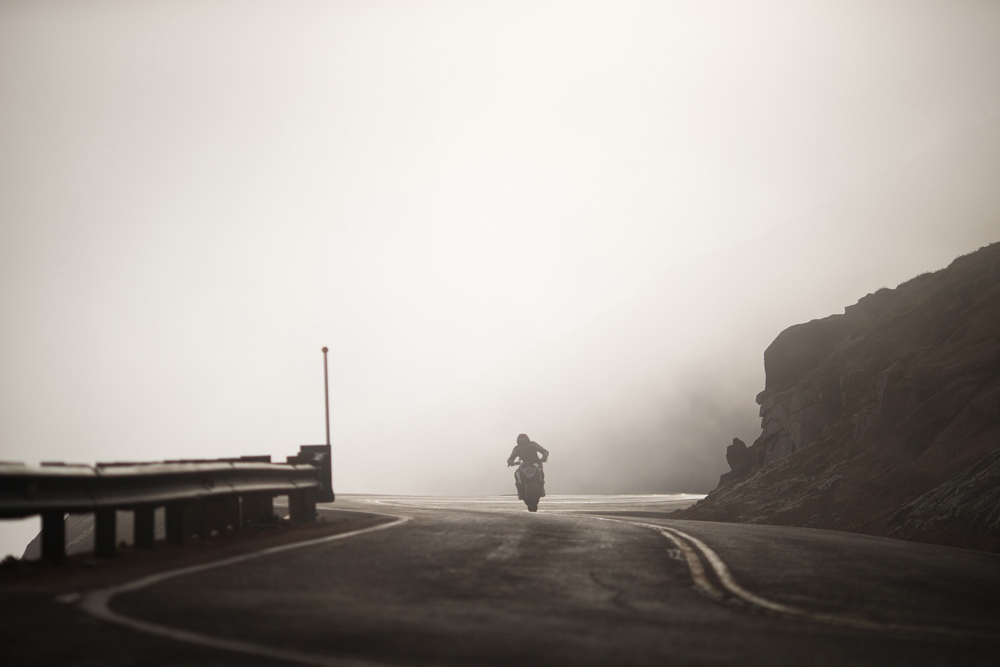 Conditions during early morning practice in the W’s was not ideal. Visibility was severely reduced, but it made for incredible photos.
Conditions during early morning practice in the W’s was not ideal. Visibility was severely reduced, but it made for incredible photos.
Third Time’s a Charm?
This is my third year at the Pikes Peak International Hill Climb. For the last two, I have competed for KTM North America and Cycle News, with incredible support from Pirelli and road race manager, Oscar Solis.
This year was to be slightly different, as last year I had signed to ride the Spanish-built Bottpower BOTT XR1R, a custom motorcycle that uses the old two-valve Buell air-cooled motor and was ridden to the 2017 Exhibition Class win by Travis Newbold.
That ride was short-lived. Getting money to go racing is never easy, and this proved just so for Bottpower, who sportingly pulled out of the race at the end of April and handed their entry to me, if I could find a bike and program with which to compete just six weeks before race day.
Luckily for me, my old team welcomed me back with open arms. I felt like a dog with its tail between its legs, because I was the one who left them, thinking they wouldn’t want to run me for a third year. What’s the saying? To assume only makes an “ass” out of “u” and “me…”
My 2017 KTM 1290 Super Duke R had not turned a wheel since last year’s race. It sat in KTM’s workshop for a full year on a battery trickle charger, so all that was needed to make it mountain-ready was a fresh gut of oil, some new spark plugs and some new tires.
I was ecstatic. I love the KTM Super Duke. It’s a delightfully brutish steed, a 1970s muscle car reincarnated as a 2017 naked bike. It has nothing to do with sense and sensibility and everything to do with going fast—with a one-piece bar. You gotta be comfortable.
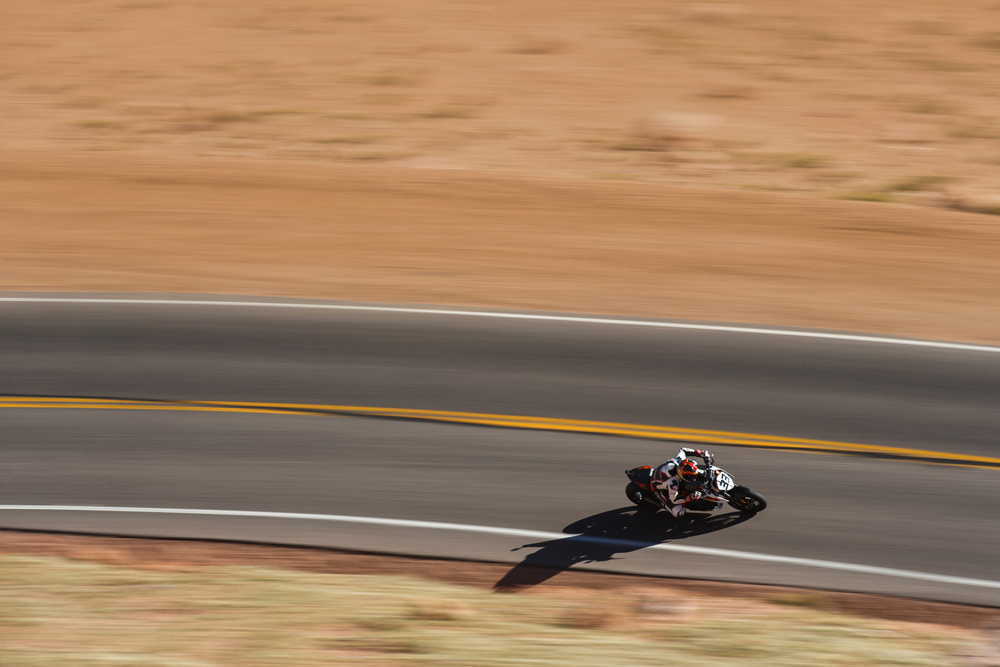 By day four, the KTM’s suspension settings were sorted and Rennie and Carlin were swapping fastest times.
By day four, the KTM’s suspension settings were sorted and Rennie and Carlin were swapping fastest times.
This year, I jumped on the bandwagon of the man fast becoming the ultimate Pikes Peak racer. Chris Fillmore attempted to take another race record in 2018, this time in the Middleweight class. He decimated the overall race record in 2017, setting a 9:49.625 on the same Super Duke as mine, some three seconds up on the old mark set by Carlin Dunne back in 2012, the year the mountain was finally fully paved.
For 2018, Fillmore had a new weapon in the new KTM 790 Duke. It’s a bike not yet on U.S. shores but when you’re as important to KTM as Fillmore is, things can happen. This little dynamo had very little mods from stock, yet in his capable hands proved to be a choice machine.
Fillmore would end the 2018 race third, only 4.9 seconds off the overall victory against bikes with near twice the capacity. He blitzed the Middleweight class competition, setting the bar at 10:04.038, some 30 seconds faster than the previous record set by Codie Vahsholtz in 2017 (check out the Chris Fillmore’s Pikes Peak KTM 790 Duke story and video for exactly what’s been done to the 790 to turn it into a real racer).
The 1290 Super Duke is a known quantity, and with Pirelli back on board for another year, everything clicked into place without a drama. We also took on board a new sponsor in Dymag wheels, who sent us two sets of ultra-gorgeous carbon fiber wheels to race with. These new carbons took a bit of un-sprung mass out of the equation, but also proved to be a headache with suspension settings, as their lighter mass made getting the KTM to handle correctly a serious chore.
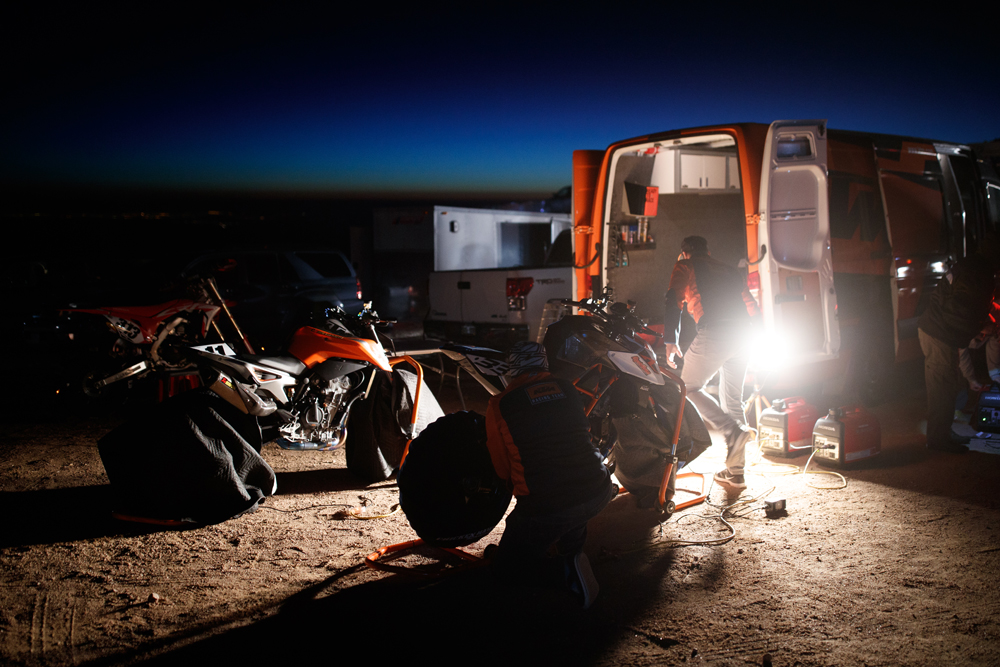 Early, early morning on top of Devil’s Playground. It was cold. Really, really, cold.
Early, early morning on top of Devil’s Playground. It was cold. Really, really, cold.
Chasing Tails
The two-day tire test, the week prior to race week, felt like nothing short of a disaster. Having hardly ridden at anything like race pace leading up to the test, I felt dodgy on the bike, to say the least. Day One was held from the mid-section of track to the finish, with Day Two held on the bottom third that makes up the qualifying route.
The Dymags were playing havoc with the suspension settings, and by the third run I was 20 seconds slower than Carlin Dunne. Twenty whole seconds. I may as well not have been there. One run from the finish, I came in with a bike that refused to turn, handle or inspire anything remotely to do with confidence. The KTM was fighting me everywhere, so team mechanic Nate took the suspension right back to mid-level soft settings, and we worked forward from there.
The final run netted some speed, knocking off 10 seconds and making the bike feel somewhat familiar.
By the end of the second test day, we’d figured it out. Working with Nate and Fillmore’s former AMA Superbike Crew Chief Ulrich Toporsch, the KTM and I were just two seconds off leader Carlin in second overall. Not a bad improvement, I thought.
Where we were going wrong was stiffening everything up and giving more and more rebound damping, when we should have been doing the reverse. The softer and more relaxed we made the bike, the better it performed. By the last run, all we needed was a click or two of compression and rebound, just playing with different settings, to find the right balance.
Another factor that would prove crucial was the Pirelli SC0 rear tire. This is the softest compound Pirelli has available, and one that really only works when track temps are super-hot. When the conditions are good, the SC0 gives the kind of grip racers dream of. Big handfuls of throttle are met with equally large handfuls of grip, but when it doesn’t work, it’s like riding on ice.
Carlin and I traded fastest days throughout practice week. Oddly enough, for the first time in many years, the first day of official qualifying was held on Tuesday, rather than Friday. Thus, I took pole position by 1.3 seconds, with Carlin bettering me on the second day in the hairpins by 2.7 seconds.
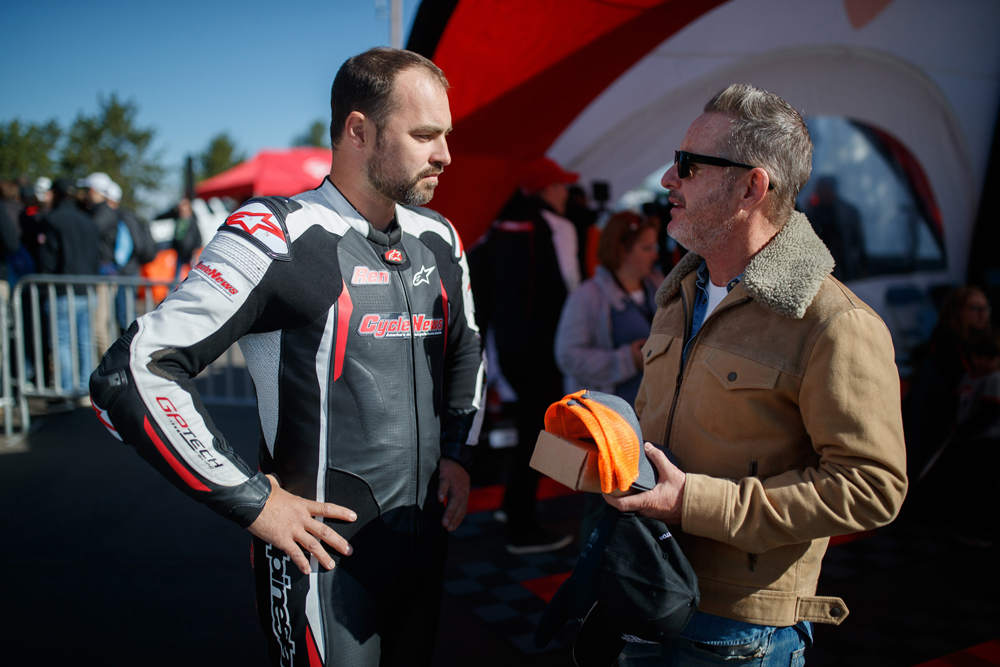 “So then I flipped this car and they paid me $5000!” Greg Tracy does his best to keep Rennie’s nerves at bay.
“So then I flipped this car and they paid me $5000!” Greg Tracy does his best to keep Rennie’s nerves at bay.
Feeling Good
There have been few times in my life where I felt better on a motorcycle than in the final run of day three, across the top of the mountain. With only three flying runs thanks to delays involving crashes with Davey Durell and Japan’s Akinori Inoue (thankfully, without injury), there wasn’t a great deal of time on track, and at the end of the second run I was one second slower than Carlin—a 2:46 to a 2:45.
Another hold-up meant I was the last rider to leave for the third and final run, which would be a prelude to the race itself. Plus, I had a score to settle with the top section of the track as it had always scared me—maybe more than it should have—thanks to its massive speeds, blind cliff corners and enormous bumps, especially in the final three miles.
A few deep breathes, some positive affirmations muttered, and the throttle pinned. I came over the line, and gave a quick yell in the helmet. It felt good. I knew it was fast, but I was surprised to see I went 3.7 seconds faster than Carlin in second place. If only I could always ride like that.
But Carlin wasn’t done, saving his best mind game for last on Friday morning. On the section of the track on which I claimed pole position on Monday, Dunne smashed home a staggering 4:07.735, some 4.1 seconds quicker than I could muster. My time was set on a totally shagged SC0 tire that had seen two days of riding, but even with a new tire, I don’t know if I could have gone more than two seconds faster than I did. Carlin was hugely impressive.
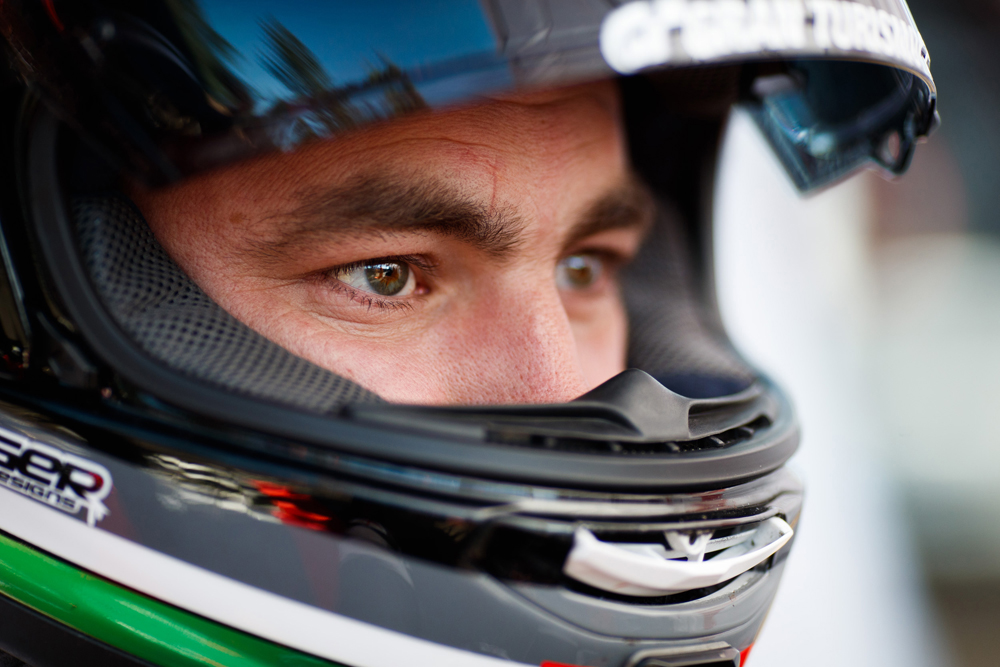 Minutes before the start, and it’s all in your head now, boy.
Minutes before the start, and it’s all in your head now, boy.
The Weather Decides
Between the end of final practice on Friday and race day on Sunday, a massive thunderstorm drenched Colorado Springs and the Pikes Peak mountain. It was a short storm, lasting only a couple of hours, but it was violent enough to wash away all the rubber laid down by the bikes and cars over two weeks of competition and bring all the shit and dirt from the mountain onto the track. That made tire choice critical, but I trusted my gut and fit a scrubbed-in SC0 rear and SC1 front on race morning, confident the track had enough heat in it to make them work.
It did, until Rob Barber fell from the Buckeye Current RW-3x electric machine at the second-to-last hairpin before Devil’s Playground. Rob’s front brake lever came right back to the handlebar and he jumped off at over 100 mph, smashing into the rocks as his bike self-destructed around him.
We knew nothing of his fate, as the race organizers have adopted a policy of full silence to dissuade any whispers that can come from such an event. All I knew was there was a half-hour delay, and in that time, I watched a massive, menacing grey cloud roll in and cover one third of the mountain, dropping temperatures down with it.
Had I thought of it at the time, I’d have put on the harder SC1 as that would’ve worked better, given the conditions. But I didn’t, and before long Durell, Vahsholtz, Fillmore and Dunne had all jumped on their bikes and left the line. Then it’s my turn.
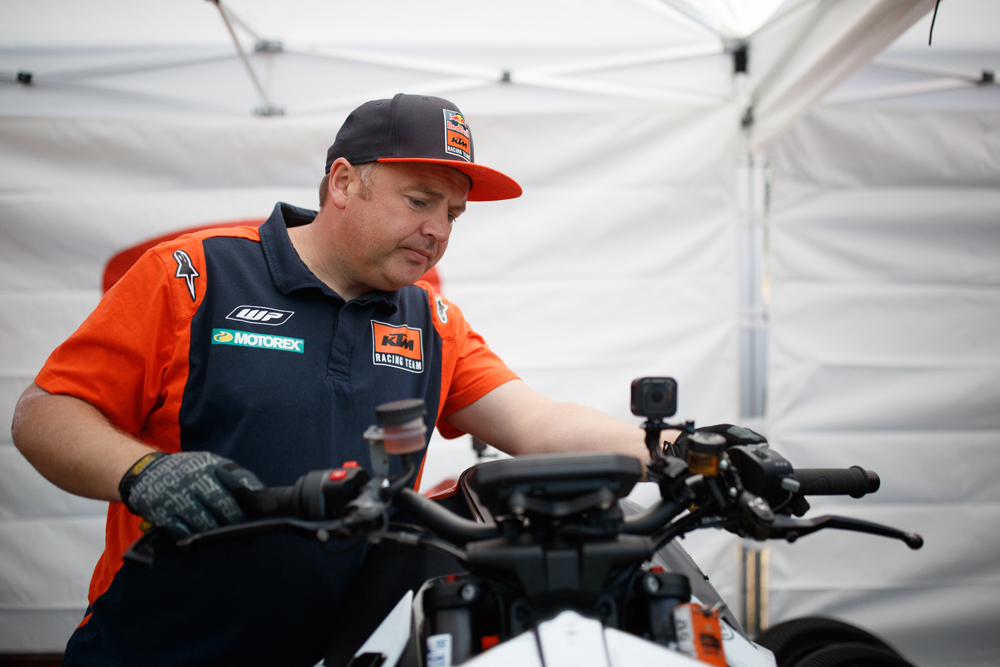 David O’Connor does some last-minute checks to the Super Duke before launch time.
David O’Connor does some last-minute checks to the Super Duke before launch time.
Tunnel Vision
Plenty as they are, you don’t notice the spectators as you roll to the line. It’s simply Frank you focus on, the man who will give you the 10-second countdown to send you to your fate.
Frank lights the green and we’re off. The timing starts as you blast under the start-line banner, and then it’s you and the mountain. But by turn three of 156, the fast-downhill left taken in fifth gear on the Super Duke, I know conditions are far from ideal.
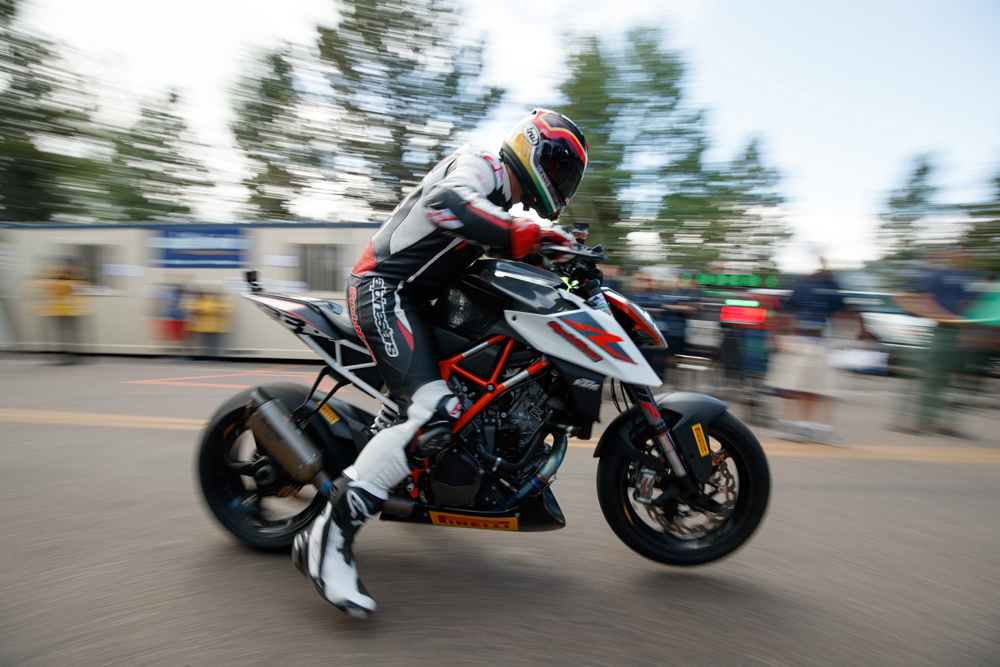 Clutch out, throttle pinned. It’s go time.
Clutch out, throttle pinned. It’s go time.
I go into that left hard, but no harder than in qualifying when my bike, body and brain was warm from previous runs. The Super Duke hits the greasy spot and under-steers towards the trees, and for a split-second I think I’m in real, real trouble.
Back on line for the approaching left and double rights, I tell myself to calm down and hit my lines. The grip level is getting less and less the higher we go, and I lose the front more times than I can count thanks to tires not performing, track temps, and very importantly, human error.
By the W’s, I am sure this run is done. I feel tragically slow in the hairpins because every time I brake hard, the rear comes around, backing itself in. Backing it in may look cool, but it isn’t the fastest way up Pikes Peak—you want to remain smooth and keep sliding to a minimum because unlike a real racetrack, the camber at Pikes is constantly changing to extremes so having a sliding bike while negotiating these corners is not ideal.
Still, I’m not going to give up.
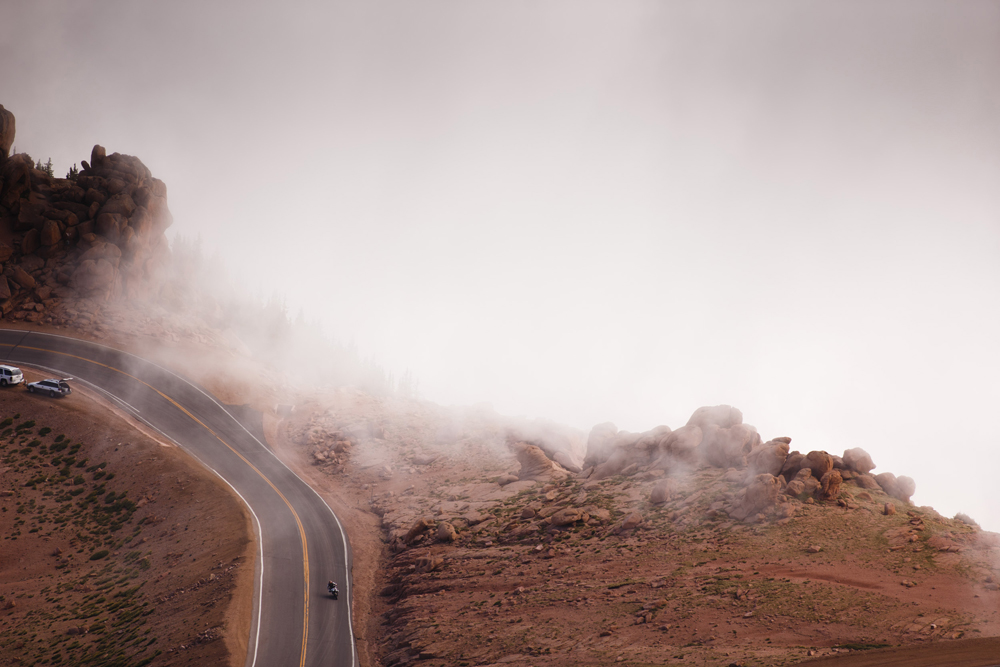 The race day cloud. Twenty minutes prior to this shot being taken, the sky was a beautiful blue as Rennie charges through the W’s.
The race day cloud. Twenty minutes prior to this shot being taken, the sky was a beautiful blue as Rennie charges through the W’s.
The rear Pirelli feels exactly the same as the 2016 race, when I think I either have a flat or the bike is dropping oil on the tire. In reality, what is happening is the tire tearing. It just isn’t warm enough to run the SC0, but by the final third of the track the tire starts to come somewhat good, and I pin the gas it has hard as I can.
The track also changes to something more predictable. The grip over the top is pretty good, miles better than the previous two sections, so I have more confidence to really thrash it.
I come over the line, totally knackered. I’m not confident in the outcome, but then I see a bunch of people clapping and smiling and the TV cameras approaching, and for a second I think I may have actually won the thing.
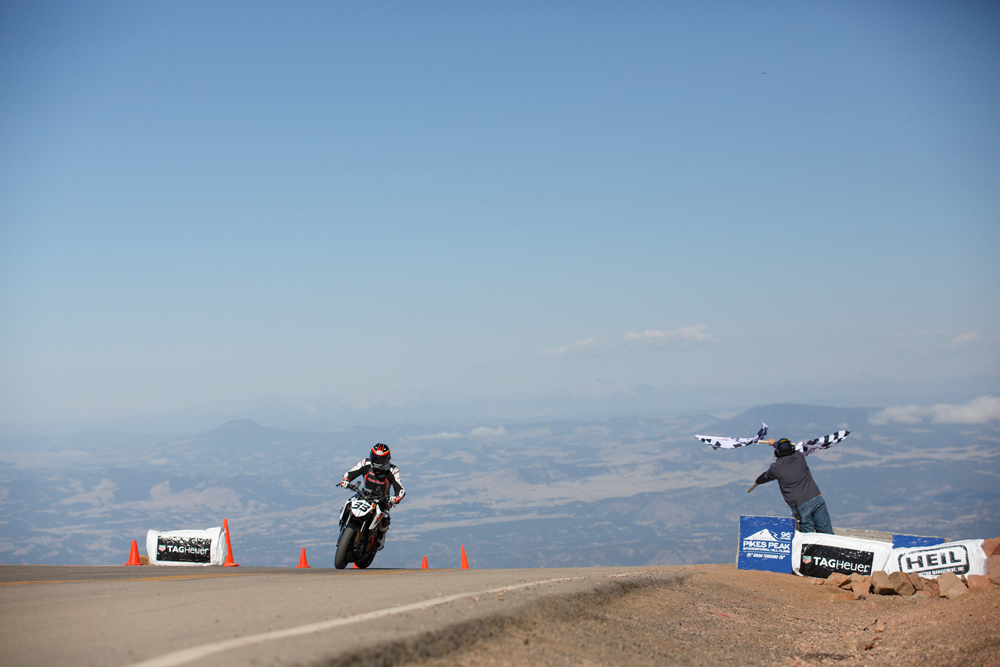 Over the line, and under a second off finally taking an overall win. That one stung.
Over the line, and under a second off finally taking an overall win. That one stung.
Then Chris Fillmore delivers the news.
“Buddy… you’re only a couple of tenths off first,” he says, with a smile of commiseration plastered on his face.
It dawns on me that I’ve lost one of the closest finishes in Pikes Peak history. It feels like I’ve been kicked in the d**k by Superman. Carlin Dunne has done it again, this time by just 0.692 seconds. That’s one mistake, one wide turn, one blink of an eye, over 12.92 miles and 156 corners—it is my nightmare bought to life.
I can try to rationalize it all I want, but in the end, I am beaten by the better rider on the day. One of the greatest ever to take the Pikes Peak challenge, Carlin Dunne is a true legend, and I can hold my head high that I ran him harder than anyone has before at America’s Mountain, even if I am on the losing side.
I still have business at that mountain. It’s a place that holds a piece of my heart and a large chunk of my insanity. I hope to be back for next year, and will do everything in my power to make it happen.
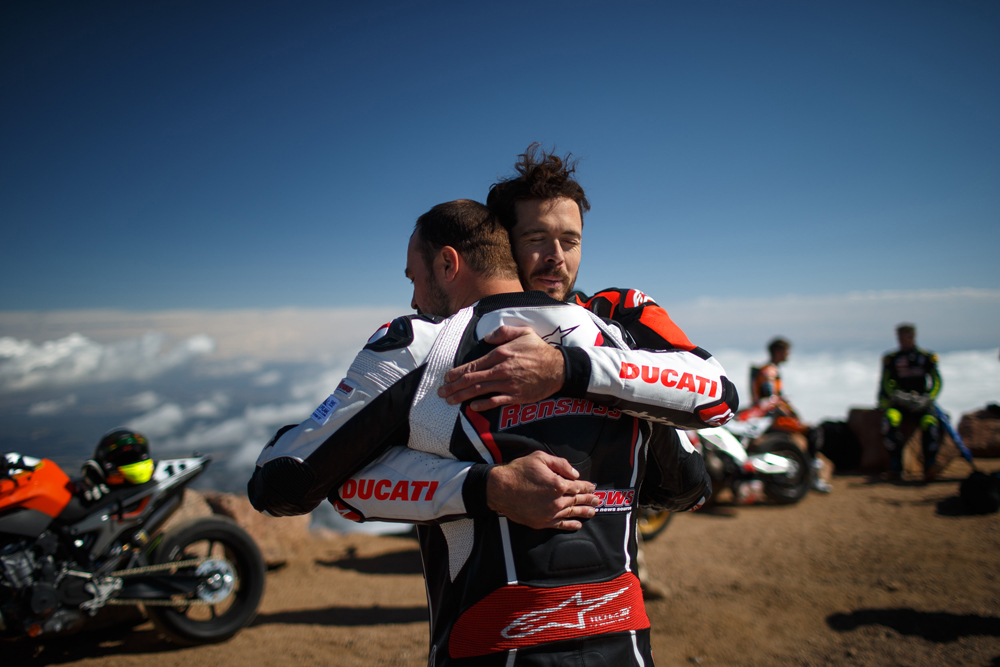 The two fastest men up Pikes Peak give each other a congratulatory hug. There was no denying Carlin earned it.
The two fastest men up Pikes Peak give each other a congratulatory hug. There was no denying Carlin earned it.
The Run
Here it is. This is Rennie’s run up America’s Mountain for the 2018 Pikes Peak International Hill Climb. Strap yourself in for a wild ride!
Thank You, Guys
Anyone that has pursued anything remotely competitive on a motorcycle knows it costs money, time and resources, usually all at once.
I have been incredibly lucky here at Cycle News to have partnered with a few very important and passionate companies, all of whom have played an extremely important role in this endeavor.
First, I need to thank Tom Moen, John Hinz, David O’Connor, Nate Abila and Chris Fillmore at KTM North America for first, allowing me to race the KTM 1290 Super Duke R under the umbrella of KTM North America, and secondly, to maintain it over the course of race week. The bike has never been anything less than exemplary. The way the machine was prepared makes you realize guys on actual race teams really do have it good.
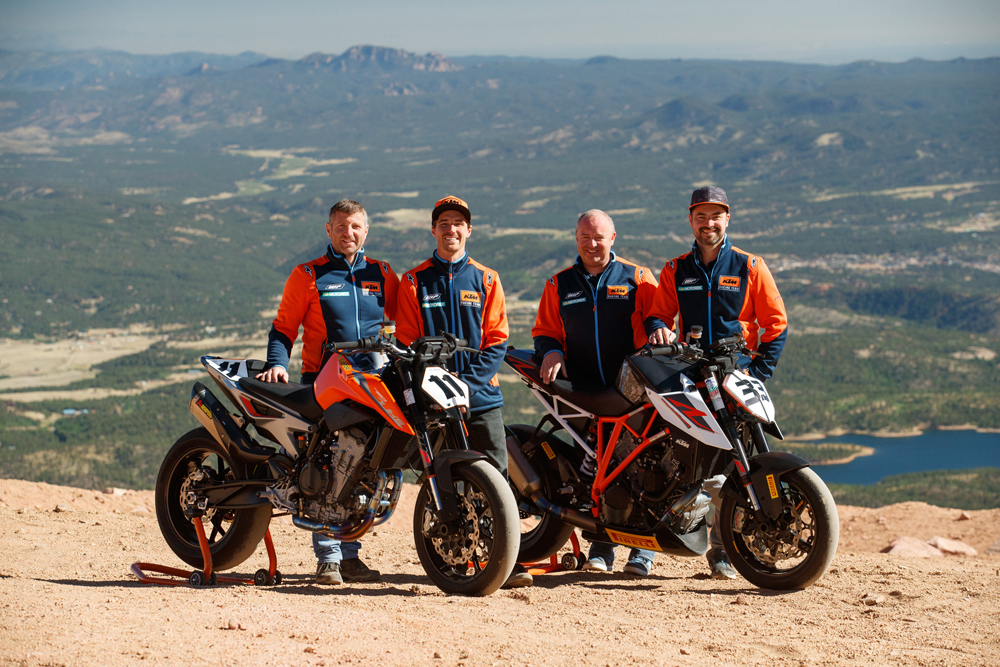
The second group I need to thank is Pirelli Moto USA and Oscar Solis. Oscar has become a great friend over the years, and Pirelli as a company has been behind the Pikes Peak journey since we started it back in 2016.
The Pirellis are the tire for this place, regardless if this year we couldn’t get them to work properly in the race but that doesn’t have anything to do with the tire and everything to do with the track conditions, which are the most unique on earth in terms of asphalt racing. The support Pirelli has given us has been extraordinary, and we are absolutely in their debt.
Dymag came on board for the race at the last minute this year, thanks to the efforts of Jamie Nicely. The wheels were an outstanding addition to the Super Duke, even if they initially caused us a few headaches with the suspension settings. Once sorted, the Super Duke would turn direction much faster than with the standard wheels, which is saying something because the standard wheels are extremely good. The carbon wheels are expensive, but they represent one of the best value dollar-for-dollar performance improvements you can make to your machine.
Erik Peat, Mike Stokes and the crew at Apex Sports in Colorado Springs have been a part of this Pikes Peak journey since the beginning, allowing us to use their facilities and giving us innumerable laughs along the way. Thanks for making race week somewhat easier, guys.
Finally, I need to thank Kit Palmer, Sean Finley, Jesse Ziegler and Bryan Robb at Cycle News. These guys give me the best job in the world and allow me to indulge this Pikes Peak dream, even though I know it drives them nuts.
Thanks again, everyone. It means the world to me.CN